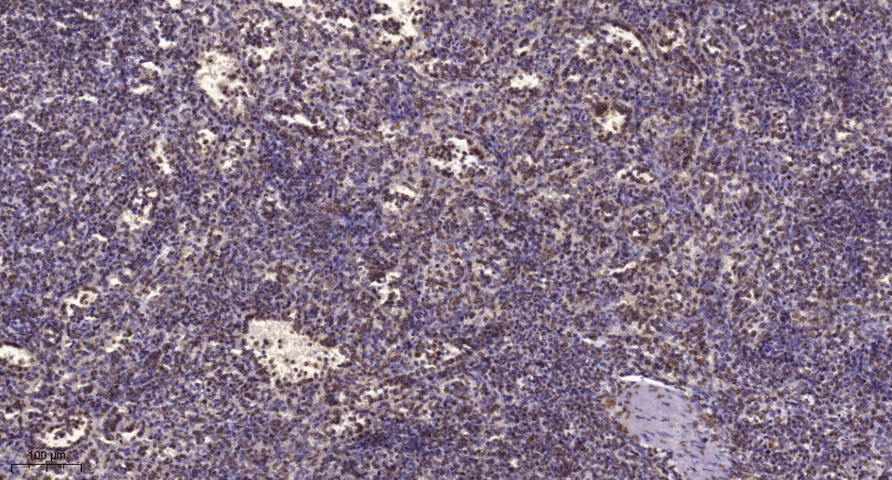CHD8 Polyclonal Antibody
- Catalog No.:YN0594
- Applications:IHC;IF
- Reactivity:Human;Rat;Mouse;
- Target:
- CHD8
- Fields:
- >>Wnt signaling pathway
- Gene Name:
- CHD8 HELSNF1 KIAA1564
- Protein Name:
- Chromodomain-helicase-DNA-binding protein 8 (CHD-8) (EC 3.6.4.12) (ATP-dependent helicase CHD8) (Helicase with SNF2 domain 1)
- Human Gene Id:
- 57680
- Human Swiss Prot No:
- Q9HCK8
- Mouse Swiss Prot No:
- Q09XV5
- Rat Swiss Prot No:
- Q9JIX5
- Immunogen:
- Synthesized peptide derived from part region of human protein
- Specificity:
- CHD8 Polyclonal Antibody detects endogenous levels of protein.
- Formulation:
- Liquid in PBS containing 50% glycerol, and 0.02% sodium azide.
- Source:
- Polyclonal, Rabbit,IgG
- Dilution:
- IHC 1:50-300. IF 1:50-200
- Purification:
- The antibody was affinity-purified from rabbit antiserum by affinity-chromatography using epitope-specific immunogen.
- Concentration:
- 1 mg/ml
- Storage Stability:
- -15°C to -25°C/1 year(Do not lower than -25°C)
- Observed Band(KD):
- 283kD
- Background:
- This gene encodes a DNA helicase that functions as a transcription repressor by remodeling chromatin structure. It binds beta-catenin and negatively regulates Wnt signaling pathway, which plays a pivotal role in vertebrate early development and morphogenesis. Mice lacking this gene exhibit early embryonic death. Alternatively spliced transcript variants encoding different isoforms have been found for this gene. [provided by RefSeq, May 2010],
- Function:
- function:DNA helicase that acts as a chromatin remodeling factor and regulates transcription. Acts as a transcription repressor by remodeling chromatin structure and recruiting histone H1 to target genes. Suppresses p53/TP53-mediated apoptosis by recruiting histone H1 and preventing p53/TP53 transactivation activity. Acts as a negative regulator of Wnt signaling pathway by regulating beta-catenin (CTNNB1) activity. Negatively regulates CTNNB1-targeted gene expression by being recruited specifically to the promoter regions of several CTNNB1 responsive genes. Involved in both enhancer blocking and epigenetic remodeling at chromatin boundary via its interaction with CTCF. Acts as a suppressor of STAT3 activity by suppressing the LIF-induced STAT3 transcriptional activity. Also acts as a transcription activator via its interaction with ZNF143 by participating to efficient U6 RNA polymerase I
- Subcellular Location:
- Nucleus . Localizes to the promoter regions of several CTNNB1-responsive genes. Also present at known CTCF target sites. .
- Expression:
- Brain,Duodenum,Epithelium,Liver,Lung,Lymph node,Spleen,Uter
- June 19-2018
- WESTERN IMMUNOBLOTTING PROTOCOL
- June 19-2018
- IMMUNOHISTOCHEMISTRY-PARAFFIN PROTOCOL
- June 19-2018
- IMMUNOFLUORESCENCE PROTOCOL
- September 08-2020
- FLOW-CYTOMEYRT-PROTOCOL
- May 20-2022
- Cell-Based ELISA│解您多样本WB检测之困扰
- July 13-2018
- CELL-BASED-ELISA-PROTOCOL-FOR-ACETYL-PROTEIN
- July 13-2018
- CELL-BASED-ELISA-PROTOCOL-FOR-PHOSPHO-PROTEIN
- July 13-2018
- Antibody-FAQs
- Products Images

- Immunohistochemical analysis of paraffin-embedded human spleen. 1, Tris-EDTA,pH9.0 was used for antigen retrieval. 2 Antibody was diluted at 1:200(4° overnight.3,Secondary antibody was diluted at 1:200(room temperature, 45min).

- Western Blot analysis of various,using primary antibody at 1:1000 dilution. Secondary antibody(catalog#:RS23920) was diluted at 1:10000



